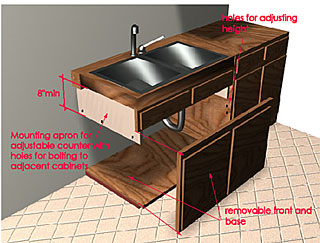Parking:
2% min. accessible spaces; more provided if needed for tenants
with disabilities.
Parking spaces reserved for disabled drivers 16-ft. wide (accommodates
a van with side lift) or 5-ft. wide access aisle next to 8 or
9-ft. wide space.
Shared spaces:
Facilities used by all residents in common: all should be accessible
or at least one of each type provided.
Facilities serving group of dwelling units: accessible if one
or more units is accessible.
Circulation
routes - common spaces:
Exterior: at least one accessible route from each accessible dwelling
to each accessible site facility.
Interior: at least one accessible route from entry to accessible
dwellings to all shares spaces (laundry, mailboxes).
Elevators: all accessible.
At least one accessible entry to each accessible dwelling unit.
In multifamily buildings, this should be the main entry.
Circulation in Dwelling
Units:
No stairs to reach: kitchen, one full bath, living room, dining
room, the bedroom in one-bedroom apartments and two bedrooms or
sleeping spaces if dwelling units have two or more bedrooms, any
equipment necessary for routine maintenance, private outdoor spaces,
carports or garages.
In Visitable housing, only
the first floor and one bathroom need to be accessible.
Doors: 32-in. clear width, lever handle on entry doors; clearances
in front to allow wheelchair access, floor surface changes and
thresholds less than 1/2 in. high and beveled.
Halls: 36-in. width minimum.
Room dimensions: enough space for 36-in. clearance at sides of
bed and in front of closet, bureau.
Kitchen: 42-in. between base cabinets; 60-in. needed in U-shaped
kitchen.

Electrical Systems
Outlets: 15-in. high
minimum.
Emergency alarm: visual/audible alarm connected to emergency power
supply and fire alarm control.
Thermostats: 48-in. maximum mounting height.
Adaptable Kitchens:
Removable base and cabinet fronts at sink and counter work area.
Sink and mix center height of counter adjustable to 36-in., 32-in.
and 28-in. from floor to top of counter; 30 in. clearance width
under counters.
Wall cabinets above counters: mounted at 48-in. high to top of
bottom shelf.
Plumbing: rough-in for sink low enough to attach drain when sink
is mounted at 28-in.
Counter: 2-in.-thick maximum, including supporting structure.
Ovens: self-cleaning or wall-mounted: if wall-mounted, located
next to mix center.
Refrigerator/freezers: self-defrosting or vertical side-by-side
type or have 50 percent of freezer space below 54-in.
Cook-tops and sinks: if provided, insulate and protect under-side
to prevent burns or scrapes.
Closet or other storage area conveniently located to make up for
lost cabinet space if base cabinets are removed.
Adapted kitchen: eliminate wall-hung cabinets and base cabinets
under sink and mix center and replace with full height cabinet
or pantry, provide shelves above counters at 48-in. from floor.





Adaptable Bathrooms
Water closets: located at 18-in. on center to side wall; normal
height; structural reinforcement at side wall and rear wall (see
illustrations); 30-in. by 48-in. minimum clearance in front of
fixture.
Lavatory: 32-in. high; 30-in. by 48-in. floor clearance (lavatory
may project up to 19 inches into clearance); clear space underneath
or removable vanity cabinet.
Shower stall: preferred over tub; 36-in. by 36-in. or 30-in. by
60-in. size; folding seat in 36-in. size but not necessary in
60-in.-size; hand-held shower spray; structural reinforcement
for grab bars (see illustrations); controls mounted on wall opposite
seat in 36-in. stall and to one side of back wall in 60-in. stall;
36-in. by 48-in. minimum floor space; 4-in. curb maximum in 36-in.
stall; no curb in 60-in. stall.
Tub: provide seat; structural reinforcement for grab bars (see
illustrations); controls mounted near entry side of head wall;
30-in. by 60-in. minimum clear floor space; hand held shower spray.
Mirror: 40-in. maximum from floor to bottom edge.
Faucets and other plumbing controls: Single lever type.

Water closet elevations
(grab bar location shaded)

Tub elevations (grab
bar location shaded)

Tub elevations (grab
bar location shaded)

Shower stall elevations
(grab bar location shaded)

shower stall elevations (grab bar location shaded)
Adapted bathroom: install
grab bars at shower or tub and at water closet; toilet height 17-19
in. to top of seat in housing specifically for disabled or elderly
people.

